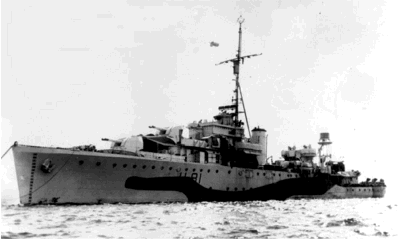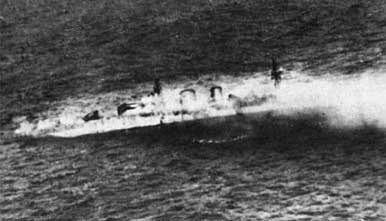|
|
HMS
Audacity, which was also separated from the main convoy but on the
opposite side to the other Escort ships, was also lit up by the
snowflakes. U-boat 751 located her and hit her with three torpedoes. The
action for the night, however, was not ended. The Escort vessels had
located a U-boat as they steered to rejoin the convoy and had succeeded
in sinking it using depth charges. This turned out to be U567. Later, as
the Escorting ships were regrouping, HMS Deptford failed to see HMS
Stork and rammed her about the quarterdeck, fortunately without
inflicting disabling damage.
|
|

|
|
HMS
Stork photographed in Plymouth Sound in 1940
Courtesy
of Steve Johnson |
|
Although the night's attacks had ended, there was
continuing concern that the Germans would renew their efforts. This fear
was heightened by the fact that the aircraft on board HMS Audacity had
gone down with the ship and they no longer could get warning of
approaching U-boats or protection from enemy Condor aircraft.
As they neared the Western Approaches, a Liberator of Coastal Command
came out to provide a screen during the final stages of the voyage. As
they neared home on 23 December 1941, they could review the success, or
otherwise, of the convoy's experiments. Three merchant vessels had been
lost as well as HMS Stanley and HMS Audacity; four U-boats had been sunk
and Walker's first encounter with the enemy had allowed him to test his
methods. The Commodore was certainly satisfied and made a signal to Walker
that he had "won a great victory".
Shortly after their return to the the UK, it was announced that
Commander Walker had been awarded the DSO. He had also been called to
the Admiralty to brief their Lordships on the tactics he had employed
during the passage. |
|

|
|
The
sinking of HMS Exeter 1 March 1942
(HMS
Exeter was a heavy cruiser of the York Class) |
|
The effect on the men was generally less favourable. People who
nowadays complain about "stress" at work should reflect on
those dark days of 1941 when all servicemen and women and especially
sailors serving in convoys such as HG76, lived their lives in a high
state of nervous tension. The uncertainty of convoy work was extremely
wearing on the nerves and on the body. During the passage, it was
impossible to grab more than a couple of hours of fitful sleep. There
was no opportunity to get restful sleep - the bell that announced "Action
Stations" could, and would, ring at any time of the day or night.
And when you sprang into action, you never knew if this time would
be the last time - as it was on that fateful December day in 1941 for
Stoker, First Class, Ernest Charles Stentiford.*
|
|
* Stokers Ernest Stentiford, George Carmichael and many
hundreds of their comrades are commemorated on the Royal Naval Memorial
on Plymouth Hoe. If you are far from Plymouth, then visit the Memorial
on an excellent website - www.webrarian.co.uk.
|
Click
here to return to Issue 37
|